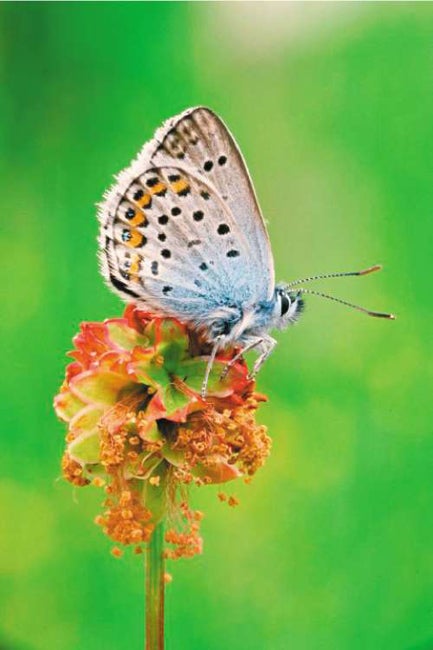Rare butterfly rises from the ashes

One of Britain's most precious nature reserves has made a remarkable comeback from a fire which devastated it two years ago today.
Thursley Common, near Godalming in Surrey, was thought to have lost much of its specialised heathland wildlife in the blaze which swept across its 400 acres, home to scarce birds such as Dartford warblers, nightjars and woodlarks, and a stronghold of the very rare silver-studded blue butterfly.
But the iconic silver-studded blue is again thriving at Thursley, the site's owners, Natural England, have found, and the reserve, one of the best remaining examples of lowland heath, is recovering strongly.
In 2006, nearly 120 firefighters battled to save the common after it went up in tinder-dry conditions – arson was suspected – and at the time it was feared the fire could lead to irreversible wildlife losses. But monitoring results show that the efforts of firefighters, conservationists and local volunteers were not in vain. Simon Nobes of Natural England, the senior reserve manager for Thursley, worked with firefighters to save the silver-studded blue colonies, which have become confined to just a handful of sites in England and Wales. "On our survey last week we found 126 butterflies at one location, an increase of more than 100 since after the fire," he said.
"The flames consumed the dry and wet heathland with frightening speed, burning out Dartford warbler nest sites, sand lizard areas and butterfly colonies, leaving a barren, scorched landscape of ash. Looking back at what was left of the reserve, it is fantastic that populations of these fragile butterflies have pulled through, showing outstanding powers of recovery."
Sir Martin Doughty, chairman of Natural England, said: "Thursley is a nucleus of threatened species, and when it went up in flames we thought our worst fears had been realised but, against the odds, it has been saved. Wildlife in England has become increasingly fragmented, and national nature reserves provide crucial refuge for endangered species, acting as pockets of biodiversity from which nature can grow."
He praised local residents who raised more than £8,000 to help rehabilitate the heathland, repair visitor facilities and to train and equip volunteer fire wardens to spot potential dangers.
Thursley National Nature Reseve is among the largest remaining fragments of Surrey heath and includes lowland heath, mire and woodland. Damp areas support carnivorous plants such as sundew, while bog asphodel and marsh orchid may also be seen.
Large populations of grayling and purple emperor butterflies were found alongside the silver-studded blue. There are also 26 recorded dragonfly species. Sandier sites on the reserve provide homes for many species of solitary bees and wasps.
Other birds seen, besides woodlark, nightjar and Dartford warbler, include hobby, merlin, peregrine and short-eared owl.
Thursley's rare species
*Dartford warbler
This tiny bird, above, is mostly found in the warmer parts of western Europe and North Africa. It has a grey back and head, a reddish throat with white spots and a red eye.
*Silver-studded blue butterfly
Named because of the metallic spots on the underside of its wings, male silver-studs have a deep-blue upperside with a black border and a row of black spots. Females are dark brown with orange spots.
Subscribe to Independent Premium to bookmark this article
Want to bookmark your favourite articles and stories to read or reference later? Start your Independent Premium subscription today.

Join our commenting forum
Join thought-provoking conversations, follow other Independent readers and see their replies